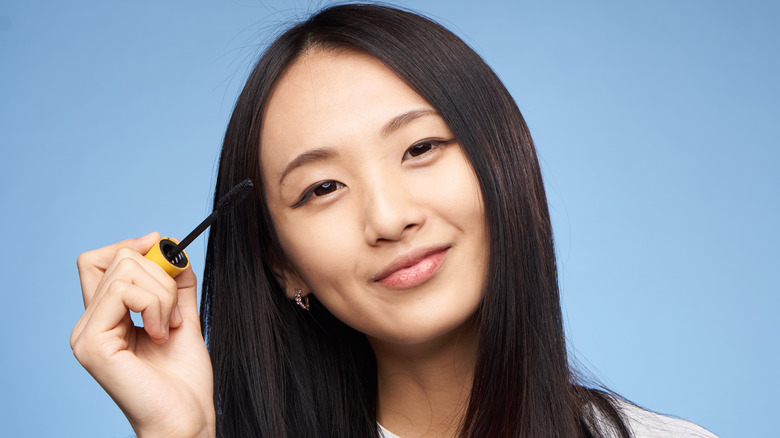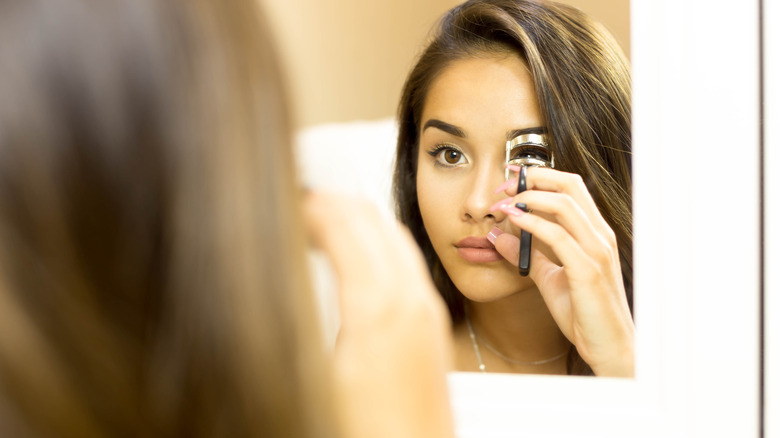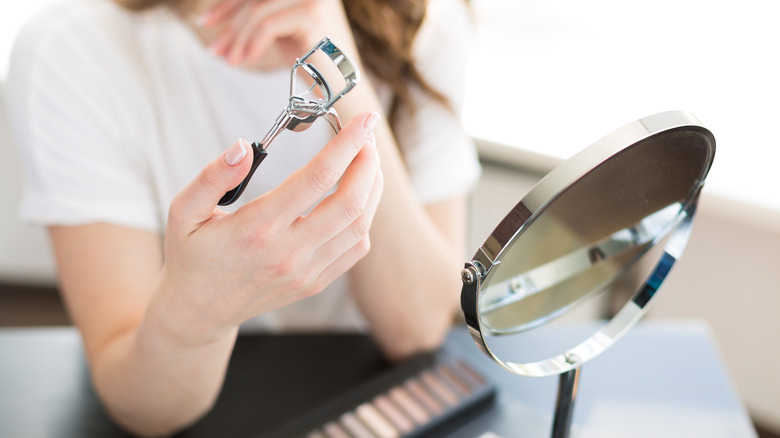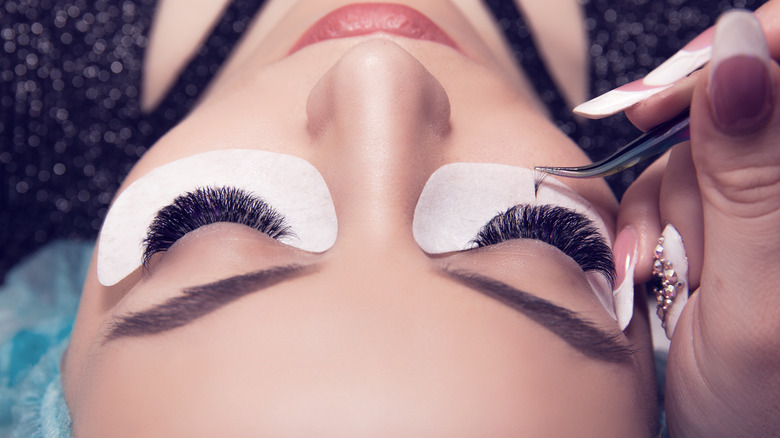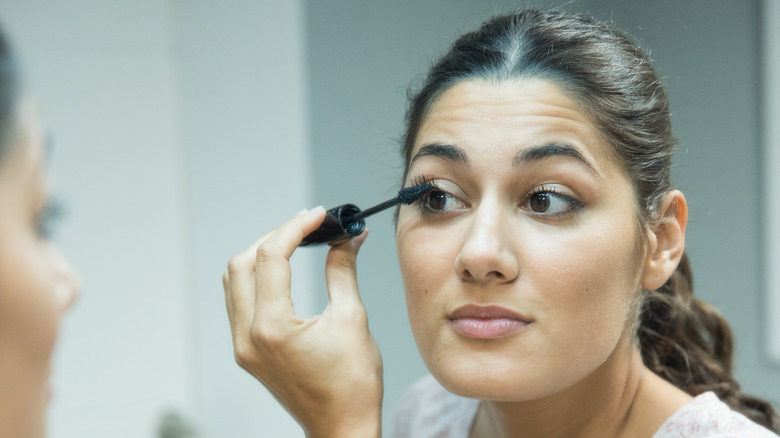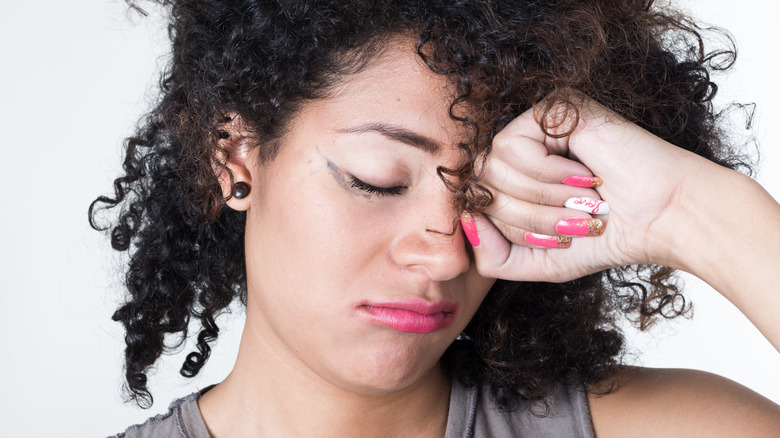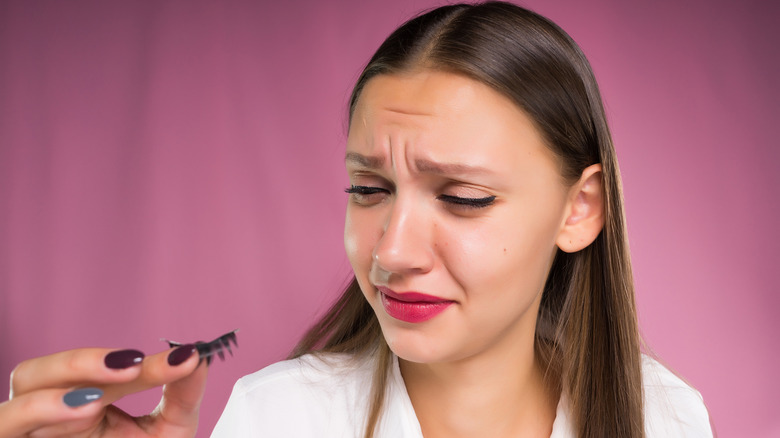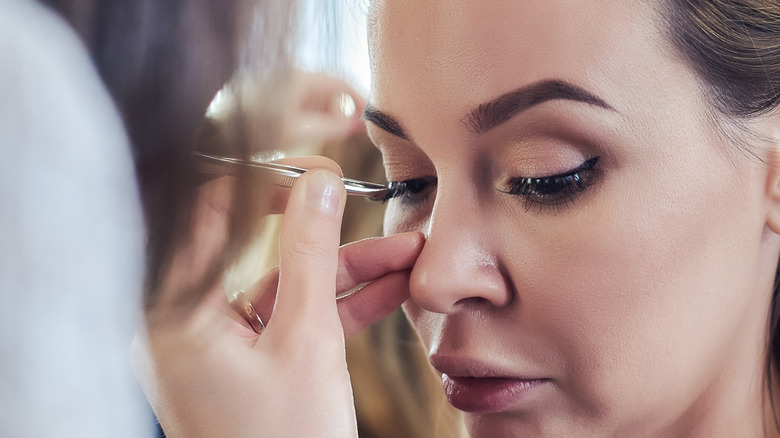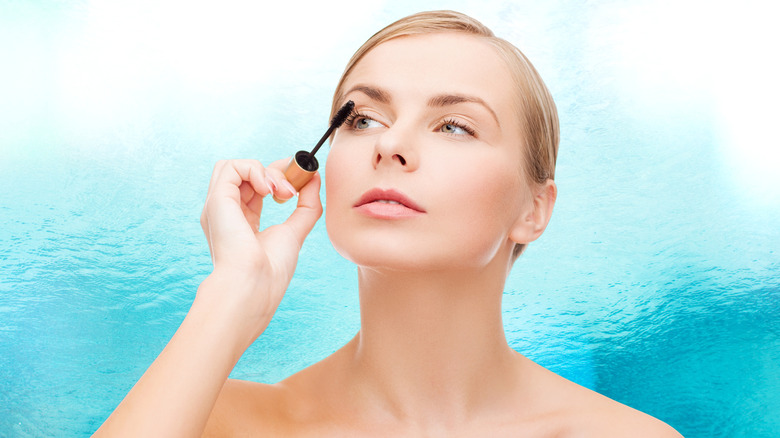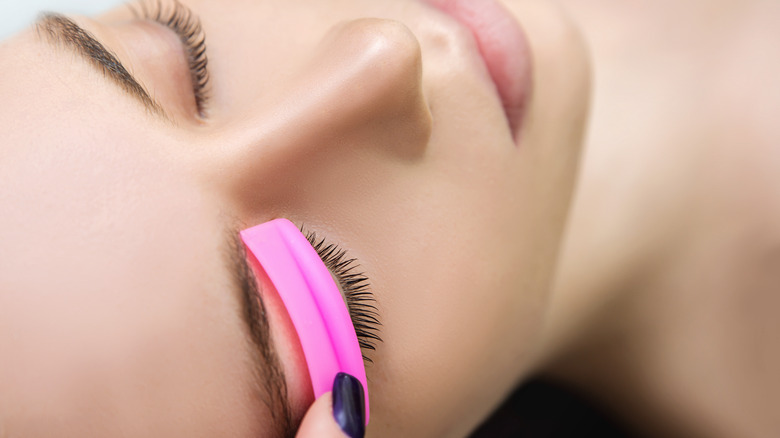Eyelash Mistakes You're Probably Making
The never-ending quest for great eyelashes has led us down quite the rabbit hole. With the quantities of eyelash curlers, volumizing mascaras, false lashes, and lash extensions on the market, it's obvious we're all pretty determined to have the best eyelashes possible. Yes, even if that means gluing on falsies each and every day or handing over some serious cash to a lash specialist. Others have eschewed the faux alternatives and have instead decided to enhance their own lashes through lash perms. It's a real thing — we promise — and works much the same way as perms do for your hair.
If you've been critical of your lashes, thinking they're less than phenomenal, and have started considering ways to beef them up, you'll be happy to know that you can actually enhance them without any special treatments. And, even if you've already tried out extensions or other lash enhancements, you can still benefit by making a few simple changes and correcting some common lash mistakes. Here's how.
Curling your lashes after doing this
If you want curled eyelashes without spending $70 a month on a perm, there's a good chance you rely on your trusty eyelash curler. But when do you use said curler? If it's covered in black gunk, then we'll go ahead and assume you roll them after applying mascara. We're sorry, folks, but this is one of the worst things you can do to your lashes.
"In general, if you're using eyelash curlers, then you must use them correctly — before you apply mascara and not too close to the lash rim," Sabah Feroz, a brow and lash specialist at Blink Brow Bar, told Reader's Digest. "This will damage the eyelash cuticles and cause lash breakage." Yep, while you may think all of the residue that sticks to the curler is just mascara, you could actually be losing some precious lashes too. Just remember: It's perfectly okay to use an eyelash curler — as long as you do so before applying mascara.
Not replacing your eyelash curler pads
Although curling your lashes before putting on mascara is arguably the most important step in using an eyelash curler, there are other important things to remember about this beauty tool. A representative for the cosmetic brand Shu Uemura confirmed to InStyle that those little silicone pads used in your metal curlers last for just about three months. That is, if you curl your lashes every day. Celebrity makeup artist and founder of Mally Beauty, Mally Roncal, told Health you could go as long as six months.
If you notice the pads starting to wear down, don't hesitate to replace them. Otherwise, you'll be crimping your lashes between layers of metal. Ouch. Not to mention, you won't get nearly as good of a curl. Cosmetic chemist Nikita Wilson further recommended cleaning your eyelash curler every two weeks. Gently scrubbing the tool down with a cotton ball dipped in eye makeup remover or baby oil will do the trick.
Sleeping in your mascara
Even if you're diligent about removing your foundation and lipstick before climbing into bed, you might not be as fastidious about removing your mascara. You may not even think much of it, but some pretty nasty things can happen if you don't remove the cosmetic from your lashes.
According to the American Academy of Ophthalmology, one 50-year-old woman who'd been improperly removing her mascara for 25 years ended up with "follicular conjunctivitis" and "corneal erosions" from the habit. The mascara actually clumped into hard, solid masses under her top eyelids and could've severely damaged her eyes if doctors hadn't intervened, as noted by Health.
Even the more minor side effects aren't pleasant. Dermatologist Eric Schweiger told HuffPost that "significant eye irritation" can occur if mascara gets into your eyes while sleeping. Leftover mascara can also result in "clogging of the tiny hair follicles and oil glands on your eyelids." When clogged, bacteria forms and inflammation follows. "As a result, small bumps called styes or hordeolums can form," the doctor explained. It's better to play it safe and properly remove your mascara before hitting the hay.
Going too big with your extensions
Go big or go home, right? Well, not when it comes to your eyelash extensions. If you're considering extensions, you are obviously looking for fuller, longer lashes. Nevertheless, you have to be careful. Licensed cosmetologist Talin Haghnazarian revealed to Reader's Digest, "I refuse to put on a lash extension that is too heavy or too long for a natural lash." The risk of overly long lashes apparently far outweighs the reward. "You can cause permanent damage to your follicle or cause the lash to prematurely fall out," the expert explained. Eek!
But don't freak out. This doesn't mean you should totally fear getting extensions and write them off forever. By doing your research and visiting a reputable lash specialist or salon, you can avoid having the wrong type of lash applied and thus avoid having any kind of damage done to your natural lashes. Phew.
Wearing expired mascara
How long ago did you open that tube of mascara you're wearing? If it was during a different season — or worse, if you can't even remember when it was — throw it away! We'll wait. Jessica Wu, a dermatologist and an assistant clinical professor of dermatology at the University of Southern California, told Everyday Health, "Mascara has the shortest shelf life of all beauty products and should be discarded two to three months after opening."
Depending on the brand, mascara can be quite expensive — which only makes it harder to toss before you've finished the tube. Still, there are some very real health risks if you continue using your mascara past the expiration date. "You use mascara near your eyes, it's liquid — which tends to grow more bacteria — and you double dip every time you re-insert the brush into the tube, all of which increase the risk of eye infection," the doctor shared. For every day you go past that two- to three-month mark, you're just coating your eyelashes in more and more bacteria.
Rubbing your eyes
If your morning routine involves rubbing your eyes, you're actually doing a disservice to both your eyes and your eyelashes. The American Academy of Ophthalmology described eyelashes as "human whiskers." Just like whiskers on a cat or a dog, lashes can help us sense if anything is too close and incite a blink if necessary. Lashes also work to prevent dust and debris from coming into contact with our eyes. If you rub your eyes, though, you're basically undoing all of your eyelashes' hard work. Plus, if you're someone who suffers from allergies, you might just be putting what you're allergic to — like pollen — directly into your eyes. Not exactly the most pleasant experience.
"There's no reason to recommend rubbing at all," Charles McMonnies, a professor at the School of Optometry and Vision Science at the University of New South Wales in Australia, told the ABC. "Rubbing should be avoided at all times."
Tearing off your false lashes
There's no way around the fact that false lashes just aren't as comfortable as your natural lashes. But if you wear them on the reg, you're probably pretty comfortable in them. Still, as soon as you get home, you probably can't wait to tear them off. Although we totally hear you, experts recommend a less hasty approach to removing your adhesive lashes. If you rip them off like a Band-Aid, there's a good chance you're going to take off much more than you bargained for. Yep, you might just lose your natural lashes.
According to Kate Stromberg, a celebrity makeup artist at COLOR Salon in Las Vegas, Nev., you should remove your lashes in a very gentle manner. Dip a cotton swab in an oil-based cleanser to first break up the adhesive. "Then gently pull from the middle of the falsie outward to protect yourself from serious damage," Stromberg told Reader's Digest. It is a little bit of extra work, but it's definitely worth keeping your eyelashes intact, wouldn't you say?
Using anything other than medical-grade adhesive
When applying false eyelashes, the adhesive you use most certainly matters. If you're out of lash glue, do not — we repeat, do not — start eyeing up the super glue in the garage. In addition to being way too strong for the job, it can cause pain and swelling to the eyelid and socket, as noted by Metro. You'll likely end up having to see a lash specialist to dissolve the glue and you'll lose most of your natural lashes in the process. Seriously, just don't do it.
Clementina Richardson, celebrity lash expert and founder of Envious Lashes, said you must use a medical-grade adhesive when applying false lashes. "This is not something you can buy in a drugstore or a beauty supply store. Some adhesives dry clumpy and are visible, those are ones to avoid," she explained to PopSugar. "Do not use crazy glue, hair glue, or any other glue, that is a big no-no."
Always wearing waterproof mascara
Waterproof mascara is a pretty nifty invention and one that is definitely appreciated during weddings, beach vacations, and sappy movies. Even though you might not be able to predict when your next cry will be, waterproof mascara isn't a good choice for everyday wear. What makes the waterproof mascara so great also happens to be its downfall: staying power. As you likely know from trying to scrub this cosmetic from your lashes, waterproof mascara is incredibly difficult to remove.
When speaking with Reader's Digest, celebrity makeup artist Kate Stromberg revealed, "Over time, vigorous removal can tug and pull on your lash line, causing them to weaken and break." While it may be great not to have to worry about crying muddy black tears, it's certainly better than dealing with broken lashes from trying to remove your waterproof mascara.
"Instead, opt for a tubing mascara containing flexible polymers which require only warm water to remove," the expert suggested.
Tinting your lashes
You've heard of tinting your brows, but what about your eyelashes? Although brow and lash tinting are practiced in salons, both services are actually illegal in some states. If you've been thinking of darkening your lashes in the hopes of forgoing mascara, Jessica Krant, a dermatologist in New York City, told Today that it's "probably safe." She continued, saying, "But it would be a lot more reliably safe if the procedure was regulated or licensed and the dyes were FDA-approved."
As of this writing, the Federal Drug Administration states that "permanent eyelash and eyebrow tints and dyes have been known to cause serious eye injuries, including blindness" and "there are no color additives approved by FDA for permanent dyeing or tinting of eyelashes and eyebrows." Although regulations could change, it may be advisable to wait a little longer before trying out this procedure — especially when the risks are so severe.
